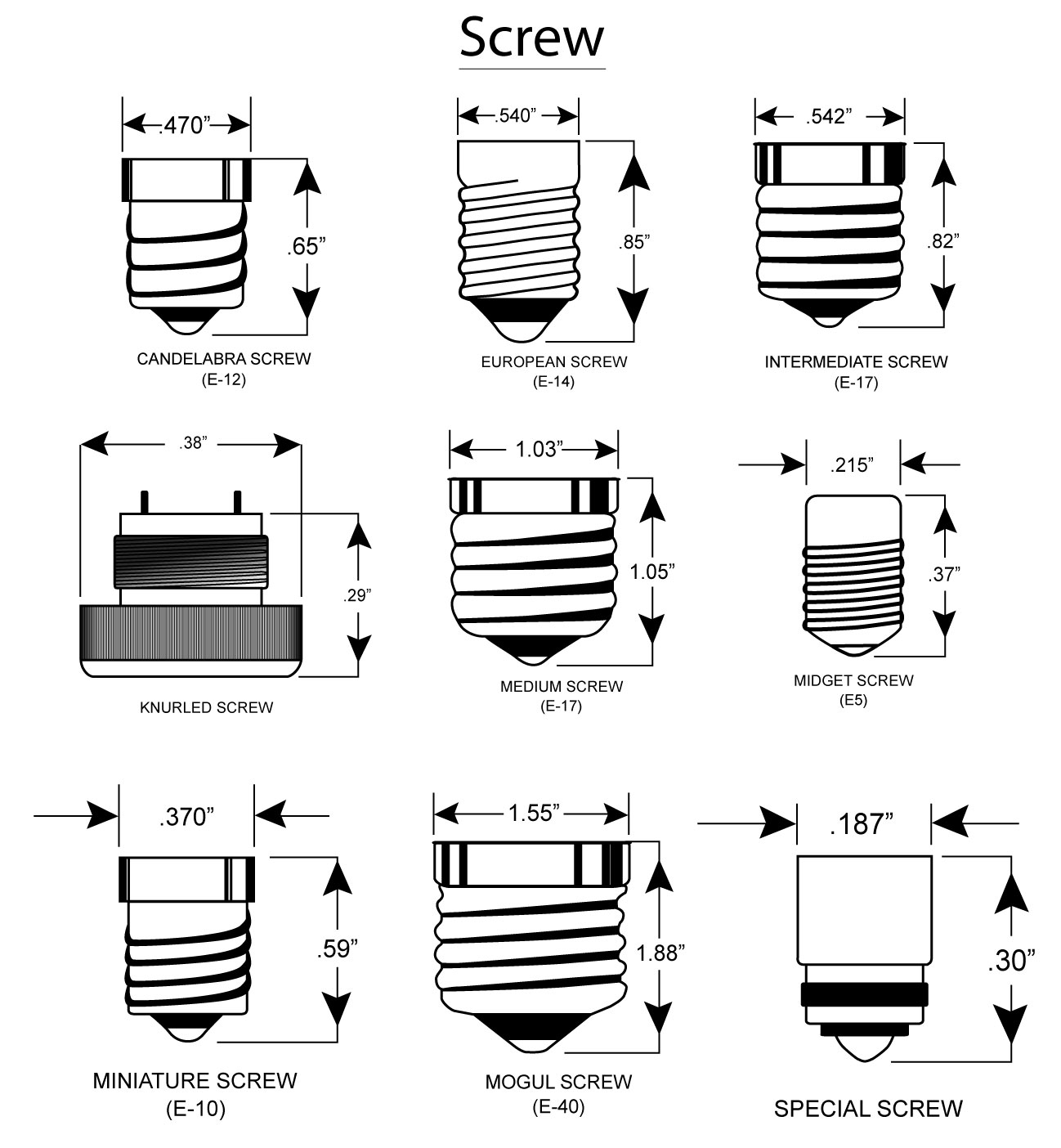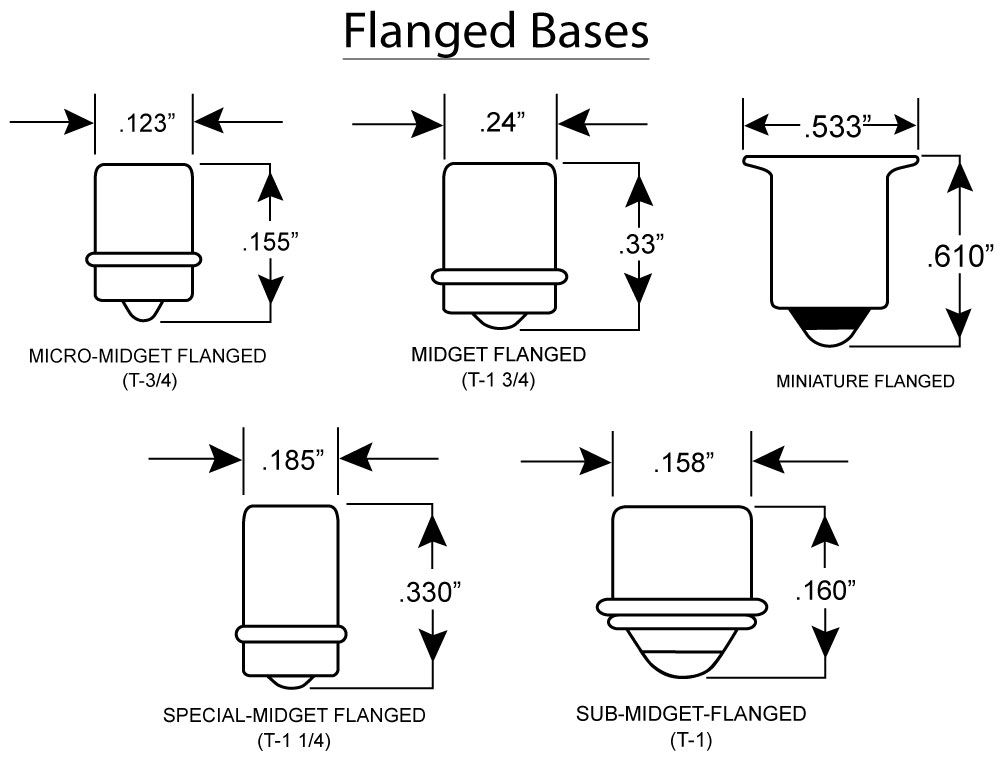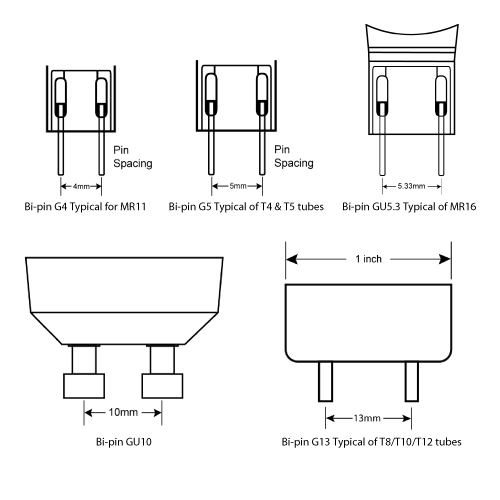E or Edison screw-in sockets and bases
Screw-in bases, also known as Edison bases and light bulb sockets are used through out the world.

The naming conventions include terms like medium base and candelabra base. Often they are referred to with a letter-number designation that starts with an "E" followed by the number of millimeters in diameter of the base. If your base ends in a "d" this indicates a double contact base, this is typically used for 3-way bulbs.
Typically North American 120VAC bases and 240VAC bases differ by only a millimeter and carry the same full name in each country. Many EagleLight bulbs support both 120VAC and 240VAC, check specifications for the bulb to determine if the bulb supports 240VAC if your application requires that.
"E" or Edison base types, sizes and names
| Base Number | Diameter | Base or Socket Name |
| E5 | 5mm | Lilliput Edison Screw Base |
| E10 | 10mm | Miniature Edison Screw Base |
| E11 | 11mm | Mini-Candelabra Edison Screw Base |
| E12 | 12mm | Candelabra Edison Screw Base |
| E14 | 14mm | Small Edison Screw Base (supports 240V) |
| E17 | 17mm | Intermediate Edison Screw Base |
| E26 | 26mm | Medium Edison Screw Base |
| E27 | 27mm | Medium Edison Screw Base (supports 240VAC) |
| E39 | 39mm | Mogul or Giant Edison Screw Base |
| E40 | 40mm | Mogul or Giant Edison Screw Base (supports 240VAC) |
F or Flange light bulb base and sockets

LED light bulb flange base types.
LED flanged bases include base types like: micro-midget flanged base, midget flanged, miniature midget flanged, sub-midget flanged, and special-midget flanged base types. These LED light bulb types are used in automotive and electronic device lighting applications.
G or Bi-pin light bulb base and sockets

The "G" base type of lamp and light bulb is used to designate a "pinned" base. This can include several pin types and different numbers of pins.
Designation is by letter(s)-numbers-optional letter: The first letters include "G" followed by an optional U, X, Y or Z. Next is a number that designates the number of millimeters between the center of each pin. Finally the optional final letter designates the number of pins, no letter implies 2 pins as does a d for double. Pin number designations include: s : Single, d : Double, t : Triple for 3 pins and q : Quadruple for 4 pins.
Examples include: GU10 base type, G24q base type, or for T8 tubes G13 bi-pin.
Designation is by letter(s)-numbers-optional letter: The first letters include "G" followed by an optional U, X, Y or Z. Next is a number that designates the number of millimeters between the center of each pin. Finally the optional final letter designates the number of pins, no letter implies 2 pins as does a d for double. Pin number designations include: s : Single, d : Double, t : Triple for 3 pins and q : Quadruple for 4 pins.
Examples include: GU10 base type, G24q base type, or for T8 tubes G13 bi-pin.
| Type | Pin to pin distance | Pin Diameter | Typical Bulbs that use this base |
| G4 | 4mm | 0.65-0.75mm | MR11 and other small halogens of 5/10/20 watt and 6/12 volt |
| GU4 | 4mm | 0.95-1.05mm | |
| GY4 | 4mm | 0.65-0.75mm | |
| GZ4 | 4mm | 0.95-1.05mm | |
| G5 | 5mm | T4 and T5 fluorescent tubes | |
| G5.3 GU5.3 GX5.3 GY5.3 | 5.33 mm | 1.47-1.65mm | MR16 and other small bulbs typically using 12/24 volts |
| G6.35 GX6.35 GY6.35 | 6.35 mm | 0.95-1.3mm | |
| G8 | 8mm | ||
| G9 | 9mm | ||
| GU10 | 10mm | bulbs using twist-lock bi-pin base | |
| G13 | 12.7mm | T8,T10 & T12 fluorescent tubes | |
| G23 | 23mm | 2mm | |
| GU24 | 24mm | 2 and 4 pin bases with center key | |
| GX53 | 53mm | used with puck shaped lamps typically twist-lock |
K or Cable connected lights and lamps
Source:





